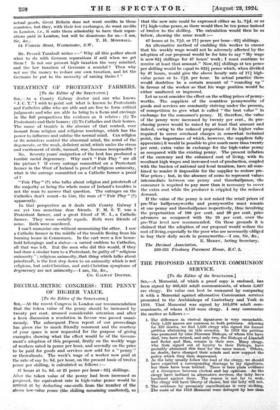DECIMAL-METRIC CONGRESS: THE PENNY OF HIGHER VALUE.
[To the Editor of the SPECTATOR.] Sin,—At the recent Congress in London our recommendation that the token value of the penny should be increased by twenty per cent. aroused considerable attention and after a keen discussion a resolution in favour was passed unani- mously. The subsequent Press report of our proceedings has given rise to much friendly comment and the courtesy of your space is now requested for the purpose of giving examples showing what the effect would be of the Govern- ment's adoption of this _proposal, firstly on the weekly wage of workers rated in pence per hour, and secondly on the price to be paid for goods and services now sold for a " penny " or thereabouts. The week's wage of a worker now paid at the rate of say is. 9d. per hour, on the present basis of twelve pence per shilling, is calculated as follows :-
47 hours at ls. 9d. or 21 pence per hour =821 shillings. After the token value of the penny had been increased as proposed, the equivalent rate in high-value pence would be arrived at by deducting one-sixth from the number of the above low-value pence (the shilling remaining unaltered), so
that the new rate could be expressed either as is. 71d. or as 171 high-value pence, as there would then be ten pence instead
of twelve to the shilling. The calculation would then be as below, showing the same result :— 47 hours at 1s. 71d. or 174 pence per hour-824 shillings. An alternative method of enabling this worker to ensure that his weekly wage would not be adversely affected by the adoption of our proposal would be for him to say "My wage
is now 824 shillings for 47 hours' work ; I must continue to receive at least that amount." Now, 824 shillings at ten pence per shilling would be equal to 8221 pence which, when divided
by 47 hours, would give the above hourly rate of 171- high- value pence or ls. 71d. per hour. In actual practice there would doubtless be a certain amount of " rounding up " in favour of the worker so that his wage position would be either unaltered or improved.
Let us next consider the effect on the selling prices of penny-
worths. The suppliers of the countless pennyworths of goods and services are constantly striving under the pressure
of competition to give what is called " the best value " in exchange for the consumer's penny. If, therefore, the value of the penny were increased by twenty per cent., its pur- chasing power would be raised by at least that amount and indeed, owing to the reduced proportion of its higher value required to cover overhead charges (a somewhat technical point, the importance of which, however, the suppliers fully appreciate) it would be possible to give much more than twenty per cent. extra value in exchange for the high-value penny as compared with the existing penny. The present inflation of the currency and the enhanced cost of living, with its resultant high wages and increased cost of production, coupled with the burden of- national and local taxation, have all com-
bined to render it impossible for the- supplier to restore pre- -War prices-; but, in the absence of coins to represent values intermediate between one penny and threehalfpence, the consumer is required to- pay more than is necessary to cover the extra cost while the producer is crippled, by the reduced demand.
If the value of the penny is not raised the retail prices of pre-War halfpennyworths and pennyworths must remain at one• penny and threehalfpence respectively, thus- involving the perpetuation of 100 per cent. and 50 per cent. price advances as compared -with the 20 per cent. over the pre-War level now recommended. On these grounds it is claimed that the adoption of our proposal would reduce the cost of living, especially to the poor who are necessarily obliged to buy their daily needs in pennyworths.—I am, Sir, &c.,


































 Previous page
Previous page